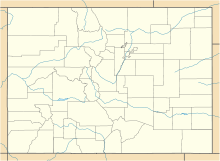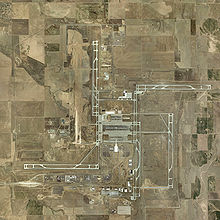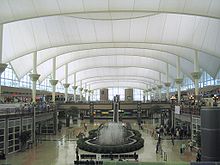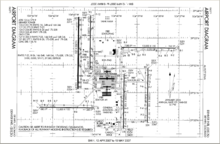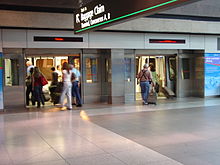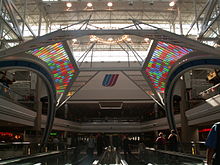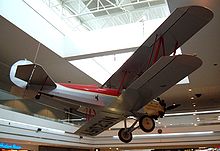- Denver International Airport
-
This article is about the current airport opened since 1995. For the airport previously serving Denver, Colorado, see Stapleton International Airport.
Denver International Airport 

IATA: DEN – ICAO: KDEN – FAA LID: DEN Summary Airport type Public Owner City & County of Denver Department of Aviation Serves Denver, Front Range Megalopolis, Northern Colorado, Eastern Colorado Location Northeastern Denver, Colorado Hub for Elevation AMSL 5,431 ft / 1,655 m Coordinates 39°51′42″N 104°40′23″W / 39.86167°N 104.67306°WCoordinates: 39°51′42″N 104°40′23″W / 39.86167°N 104.67306°W Website Map Location within Colorado Runways Direction Length Surface ft m 7/25 12,000 3,658 Concrete 8/26 12,000 3,658 Concrete 16L/34R 12,000 3,658 Concrete 16R/34L 16,000 4,877 Concrete 17L/35R 12,000 3,658 Concrete 17R/35L 12,000 3,658 Concrete Statistics (2010) Aircraft operations 635,445 Passengers 51,985,038 Source: Denver International Airport[1] Denver International Airport (IATA: DEN, ICAO: KDEN, FAA LID: DEN), often referred to as DIA, is an airport in Denver, Colorado. By land size, at 53 square miles (140 km2), it is the largest international airport in the United States, and the third largest international airport in the world after King Fahd International Airport and Montréal-Mirabel International Airport.[2] Runway 16R/34L is the longest public use runway in the United States.
So far this year, January-May 2011, Denver International Airport is the 11th-busiest airport in the world by passenger traffic with 20,608,318 passengers. It was also the fifth-busiest airport in the world by aircraft movements with over 635,000 movements in 2010.[3]
The airport is located in northeastern Denver, Colorado, and is operated by the City and County of Denver. Denver International Airport is the busiest and largest airport in the United States without non-stop service to and from Asia, although the airport is actively seeking such flights.[4] DIA was voted Best Airport in North America by readers of Business Traveler Magazine five years in a row (2005–2009)[5] and was named "America's Best Run Airport" by Time in 2002.[6]
Denver International Airport is the main hub for low-cost carrier Frontier Airlines and commuter carrier Great Lakes Airlines. It is also the second-largest hub for United Airlines (after Chicago's O'Hare International Airport). Following United's merger with Continental Airlines, the airport will be the fourth largest hub for United after Houston, Chicago, and Newark respectively. The airport is also a focus city for Southwest Airlines. Since commencing service to Denver in January 2006, Southwest has added over 40 destinations, making Denver its fastest-growing market.
Denver International Airport is the only airport in the United States to have designed and implemented an ISO 14001-certified environmental management system that covers the entire airport.[7]
Contents
Features
Aesthetics
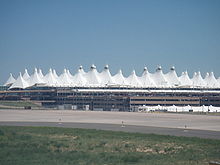 The tensile fiberglass roof of Denver International Airport resembles the area's famous Rocky Mountains.
The tensile fiberglass roof of Denver International Airport resembles the area's famous Rocky Mountains.
The airport's distinctive white tensile fiberglass roof is aesthetically designed to be reminiscent of the snow-capped Rocky Mountains in winter. The catenary steel cable system, similar to the Brooklyn Bridge design, supports the roof.[8] DIA is also known for a pedestrian bridge connecting the terminal to Concourse A that allows travelers to view planes taxiing directly underneath and provides sweeping views of the Rocky Mountains to the West and the high plains to the East.
Art
Both during construction and after the opening of the airport, Denver International Airport has set aside a portion of its construction and operation budgets for art. Gargoyles hiding in suitcases are present above the exit doors from baggage claim. The corridor from the Jeppesen Terminal and Concourse A usually contains additional temporary exhibits. Finally a number of different public art works are present in the underground train that links the main terminal with the concourses.
Mustang, by New Mexico artist Luis Jiménez, was one of the earliest public art commissions for Denver International Airport in 1993. Standing at 32 feet (9.8 m) tall and weighing 9,000 pounds (4,100 kg), "Mustang" is a blue cast-fiberglass sculpture with red shining eyes located between the inbound and outbound lanes of Peña Boulevard.[9] Jiménez died in 2006 while creating the sculpture when the head of it fell on him and severed an artery in his leg. At the time of his death, Jiménez had completed painting the head of the mustang. The sculpture was completed with the help of the artist's staff, family, and professional race-car painters, Camillo Nuñez and Richard LaVato. Upon completion, the sculpture was sent to California for assembly and then shipped to Denver. "Mustang" was unveiled at DEN on February 11, 2008.[10]
"Mustang" has received a mixed review from Colorado citizens. Many critics of the sculpture are attempting to have it removed, however the city plans to leave the installation in place for 5 years before making any decisions regarding its future. The controversy over the sculpture has received a great deal of media attention as well with coverage from the local news outlets to The Wall Street Journal, CNN, and The Daily Show.[11][12]
Automated baggage system
The airport's computerized baggage system, which was supposed to reduce flight delays, shorten waiting times at luggage carousels, and save airlines in labor costs, turned into an unmitigated failure. An airport opening originally scheduled for October 31, 1993, with a single system for all three concourses turned into a February 28, 1995, opening with separate systems for each concourse, with varying degrees of automation.
The system's $186 million original construction costs grew by $1 million per day during months of modifications and repairs. Incoming flights on the airport's B Concourse made very limited use of the system, and only United, DIA's dominant airline, used it for outgoing flights. The 40-year-old company responsible for the design of the automated system, BAE Automated Systems of Carrollton, Texas, at one time responsible for 90% of the baggage systems in the United States, was acquired in 2002 by G&T Conveyor Company, Inc.[13]
The automated baggage system never worked as designed, and in August 2005, it became public knowledge that United would abandon the system, a decision that would save them $1 million per month in maintenance costs.[14]
Solar energy system
Between February [15] and August 2008,[16] construction of an on-site, two-megawatt [17] solar energy system took place. The single-axis tracking system[18] provides 3.5 million kilowatt-hours of energy per year [17] and uses 9,200 solar panels made by Sharp.[16] Originally designed to power a jail,[19] it spares the environment of more than five million pounds of carbon emissions annually.[17] The system generates the equivalent of half the energy needs of the underground trains that move people between concourses.[20] The $13 million-plus [18] system sits on 7.5 acres (or 30,000 m2),[18] clearly visible to people entering and exiting the airport. WorldWater & Solar Technologies Corp. designed and built the system, while MMA Renewable Ventures LLC—rather than DIA—owns the solar farm and sells its energy to the airport.[17]
Telecommunications
DIA has public Wi-Fi access available throughout the airport. The free service is ad-supported through an advertising-filled HTML frame that is inserted into the top of the browser window. Users of the Wi-Fi network are also required to view a 30-second advertising video in the browser before Internet access is granted, although in many cases a click-through button is provided to avoid viewing the ad. The network is managed by FreeFi Networks, a Los Angeles-based firm.[21] T-Mobile HotSpot service is available in the airport lounges run by United Airlines and American Airlines.[22] The airport has pay-per-use kiosks which can be used to access the Internet and to play video games. The current stations were developed by Zoox Stations and were installed in 2007.[23]
Geography
The airport is 25 miles (40 km) driving distance from downtown Denver,[24] which is 19 miles (31 km) farther away than Stapleton International Airport, the airport it replaced. The distant location was chosen to avoid aircraft noise affecting developed areas, to accommodate a generous runway layout that would not be compromised by winter storms, and to allow for future expansion. The 33,457 acres (52.277 sq mi; 135.40 km2)[25] of land occupied by the airport is nearly twice the land area of Manhattan. The land was transferred from Adams County to Denver after a 1989 vote,[26] increasing the city's size by 50 percent. However, much of the city of Aurora is actually closer to the airport than the developed portions of Denver, and all freeway traffic accessing the airport from central Denver passes through Aurora.
Airport officials say its large area contributes to it having the highest number of wildlife strikes in the United States (2,090 this decade – although it ranked seventh on basis of takeoffs and landings).[27]
History
In September 1989, under the leadership of Denver Mayor Federico Peña (after whom Peña Boulevard is named), federal officials authorized the outlay of the first $60 million for the construction of DIA. Two years later, Mayor Wellington Webb inherited the megaproject, scheduled to open on October 29, 1993.
Delays caused by poor planning and repeated design changes due to changing requirements from United Airlines caused Mayor Webb to push opening day back, first to December 1993, then to March 1994. By September 1993, delays due to a millwright strike and other events meant opening day was pushed back again, to May 15, 1994.
In April 1994, the city invited reporters to observe the first test of the new automated baggage system. Reporters were treated to scenes of clothing and other personal effects scattered beneath the system's tracks, while the actuators that moved luggage from belt to belt would often toss the luggage right off the system instead. The mayor cancelled the planned May 15 opening. The baggage system continued to be a maintenance hassle and was finally terminated in September 2005,[28] with traditional baggage handlers manually handling cargo and passenger luggage.
On September 25, 1994, the airport hosted a fly-in that drew several hundred general aviation aircraft, providing pilots with a unique opportunity to operate in and out of the new airport, and to wander around on foot looking at the ground-side facilities—including the baggage system, which was still under testing. FAA controllers also took advantage of the event to test procedures, and to check for holes in radio coverage as planes taxied around and among the buildings.
DIA finally replaced Stapleton on February 28, 1995, 16 months behind schedule and at a cost of $4.8 billion,[29] nearly $2 billion over budget. The construction employed 11,000 workers.[30] United flight 1062 to Kansas City International Airport was the first to depart and United flight 1474 from Colorado Springs Airport was the first to arrive.[citation needed]
After the airport's runways were completed but before it opened, the airport used the codes (IATA: DVX, ICAO: KDVX). DIA later took over (IATA: DEN, ICAO: KDEN) as its codes from Stapleton when the latter airport closed.
During the blizzard of March 17–19, 2003, heavy snow tore a hole in the terminal's white fabric roof. Over two feet of snow on the paved areas closed the airport (and its main access road, Peña Boulevard) for almost two days. Several thousand people were stranded at DIA.
In 2004, DIA was ranked first in major airports for on-time arrivals according to the FAA.
Another blizzard on December 20 and 21st, 2006 dumped over 20 inches (51 cm) of snow in about 24 hours. The airport was closed for more than 45 hours, stranding thousands.
Design and expandability
Denver has traditionally been home to one of the busier airports in the nation because of its location. Many airlines including United Airlines, Continental Airlines, Western Airlines, TWA, the old Frontier Airlines and People Express were hubbed in Denver and there was also a significant Southwest Airlines operation at the old Stapleton International Airport. At times, Denver was a hub for three or four airlines. Gate space was severely limited at Stapleton, and the runways at the old Stapleton were unable to deal efficiently with Denver's weather and wind patterns, causing nationwide travel disruption. These problems were the main justification for the new airport. The project began with Perez Architects and was completed by Fentress Bradburn Architects[31] of Denver. The signature DIA profile, suggestive of the snow capped Rocky Mountains, was first hand sketched by Design Director Curtis W. Fentress. Seized upon by then Mayor, Federico Peña, as the iconic form he was looking for – "similar to the Sydney Opera House" – DIA's design as well as its user-optimized curbside-to-airside navigation has won DIA global acclaim and propelled its designer, Fentress, to one of the foremost airport designers in the world. Fentress Architects is currently at work on the modernization of LAX.
With the construction of DIA, Denver was determined to build an airport that could be easily expanded over the next 50 years to eliminate many of the problems that had plagued Stapleton International Airport. This was achieved by designing an easily expandable midfield terminal and concourses, creating one of the most efficient airfields in the world.
At 33,457 acres (13,540 ha),[25] DIA is by far the largest land area commercial airport in the United States. Dallas/Fort Worth International Airport is a distant second at 18,100 acres (7,325 ha). The 327-foot (100 m) control tower is one of the tallest in North America.[32] The airfield is arranged in a pinwheel formation around the midfield terminal and concourses. This layout allows independent flow of aircraft to and from each runway without any queuing or overlap with other runways. Additional runways can be added as needed, up to a maximum of 12 runways. Denver currently has four north/south runways (35/17 Left and Right; 34/16 Left and Right) and two east/west runways (7/25 and 8/26).
DIA's sixth runway (16R/34L) is the longest commercial precision-instrument runway in North America with a length of 16,000 feet (4,877 m). Compared to other DIA runways, the extra 4,000-foot (1,200 m) length allows fully loaded jumbo jets such as the Boeing 747 or Airbus 380 to take off in Denver's mile-high altitude during summer months, thereby providing unrestricted global access for any airline using DIA.
The midfield concourses allow passengers to be screened in a central location efficiently and then transported via a rail system to three different passenger concourses. Unlike Hartsfield-Jackson Atlanta International Airport upon which the midfield design was based, Concourses B and C are not connected by any kind of walkway; they are only accessible via train.
The taxiways at Denver have been positioned so that each of the midfield concourses can expand significantly before reaching the taxiways. B Concourse, which is primarily used by United Airlines, is longer than the other two concourses, but all three concourses can be expanded as needed. Once this expansion is exhausted, space has been reserved for Concourses D and E.
All international flights requiring customs and immigration services currently fly into Concourse A. Currently eight gates are used for international flights. These north facing gates on Concourse A are equipped to divert incoming passengers to a hallway which connects to the upper level of the air bridge, and enters Customs and Immigration in the north side of the Jeppesen Terminal. These gates could also be easily modified to allow boarding on both the upper deck and the lower deck of larger planes such as the Airbus A380.
As part of the original design of the airport the city specified passenger volume "triggers" that would lead to a redevelopment of the master plan and possible new construction to make sure the airport is able to meet Denver's needs.[citation needed] The city hit its first-phase capacity threshold in 2008, and DIA is currently revising the master plan. As part of the master plan update, the airport announced selection of Parson's transportation group to design a new hotel, rail station and two bridges leading into the main terminal.[33] Santiago Calatrava has been selected as the architect for the project. In addition, before hitting the 60 million passenger volume trigger, the airport is planning on constructing an additional runway, 20+ new gates on the existing concourses, two additional International Gates as well as improvements to the baggage system and passenger train.
Once fully built out, DIA should be able to handle 110 million passengers per year, up from 32 million at its opening.
Terminal and concourses
Jeppesen Terminal
Jeppesen Terminal, named after aviation safety pioneer Elrey Jeppesen, is the land side of the airport. Road traffic accesses the airport directly off of Peña Boulevard, which in turn is fed by Interstate 70 and E-470. Two covered and uncovered parking areas are directly attached to the terminal – three garages and an economy parking lot on the east side; and four garages and an economy lot on the west side.
The terminal is separated into west and east terminals for passenger drop off and pickup. Linked below is a map of the airlines associated with the terminals.
The central area of the airport houses two security screening areas and exits from the underground train system. The north side of the Jeppesen Terminal contains a third security screening area and a segregated immigration and customs area. A large fountain is currently being removed due to the expansion project currently underway.
Passengers are routed first to airline ticket counters or kiosks for checking in. Since all gates at Denver are in the outlying concourses, passengers must pass through any one of the three separate security screening areas for admittance into the secure air side of the airport (one at each end of the main terminal, with escalators down to the trains, plus one at the end of the walkway to Concourse A).
After leaving the main terminal via the train or pedestrian bridge, passengers can access 95 full-service gates on 3 separate concourses (A, B, & C), plus gates for regional flights.
Stone used in the terminal walls was supplied by the Yule Marble Quarry, also used for the Tomb of the Unknown Soldier and the Lincoln Memorial.[8]
South Terminal Redevelopment Program
A new $500 million adjunct terminal next to the Jeppesen terminal will house a railway station, to be run by Regional Transportation District's (RTD) FasTracks system, a 500-room hotel, to be run by Westin Hotels & Resorts, and a conference center, and create over 6,600 jobs that will be completed on 2016. The rail link will provide a direct linkage between downtown Denver and the airport. The design of the South Terminal was overseen by architect Santiago Calatrava. Calatrava claims that the South Terminal was inspired by an eagle flying, and kept the Jeppesen terminal a visible icon.[34]
Concourses
Denver International Airport has three midfield concourses, spaced far apart. Concourse A is accessible via a pedestrian bridge directly from the terminal building, as well as via the underground train system that services all three concourses. For access to Concourses B and C, passengers must utilize the Denver International Airport Automated Guideway Transit System. On one occasion in the late 1990s, the train system encountered technical problems and shut down for several hours, creating a tremendous back-log of passengers in Jeppesen Terminal since no pedestrian walkways exist between the terminal and the B and C Concourses. Since that day the airport's train system has continued to operate without any further major service interruption.
The concourses and main terminal have a similar layout to Atlanta's airport, except that Denver has no T gates directly attached to the terminal and the space between concourses at DIA is much wider than the space between the concourses in Atlanta. This allows for maximum operating efficiency as aircraft can be pushed away from their gate awaiting departure and other arriving and departing aircraft can still taxi through the alley behind them without delay.
The airport collects landing fees, rent and other revenues from the airlines to help offset its operating costs. Denver International Airport is owned and operated by the City and County of Denver, but does not operate using tax dollars. Instead, the airport is an "enterprise fund" generating its own revenues in order to cover operating expenses. The airport operates off of revenue generated by the airlines – landing fees, rents and other payments – and revenues generated by non-airline resources – parking, concessions revenues, rent and other payments.
On December 14, 2006, The Denver Post reported that DIA is in the design phase of expanding Concourse C in the airport's "first major concourse expansion." At least eight new gates are planned for construction at the east end of Concourse C and the project has an estimated pricetag of approximately $160 million. If the project is given the green light to move past the design phase, construction on Concourse C is estimated to take 3 years and will allow primarily Southwest Airlines, but also other carriers, to increase flight schedules at one of the nation's fastest-growing airports.
Concourse B also recently expanded with the addition of a regional jet terminal at the east side of Concourse B. This Regional Jet concourse consists of one smaller concourse or finger which is connected to Concourse B a bridges.[35] These gates allow direct jet bridge access to smaller Regional Jets. With the opening of the Regional Jet Concourse, United Airlines has left Concourse A entirely and now operates solely from Concourse B, with the exception of international flights requiring customs support.
The Airport has also announced plans to revise the Airport Master Plan to account for changing circumstances since the airport opened. According to the December 14, 2006, Denver Post and Rocky Mountain News articles, plans being drafted could possibly include an extension of the Main terminal to the South. This change would increase the number of ticketing counters and would also include a rail station for the terminus of the FasTracks commuter rail line from Denver's Union Station.
Concourse A
Note: Concourse A handles all international arrivals at Denver (excluding airports with border preclearance) as well as certain departing flights:
Concourse A has 37 Gates: A24–A68 with four international boarding gates, gate A37 is used by British Airways and gates A41 & A43 are used by Aeromexico, Air Canada and Lufthansa. Denver is one of the busiest airports worldwide with only limited international operations.
Frontier Airlines is the main carrier in Concourse A.
American Airlines' Admiral's Club is located in Concourse A.
Concourse B
Concourse B has 77 Gates: B15–B29, B31–B33, B35–B39, B42–B95
In November 2009, United and DIA reached an agreement in which United released five of its gates in the western end of the concourse. DIA in return leased these gates to United's Star Alliance partners US Airways and Continental Airlines. United Airlines has two United Clubs on Concourse B, both one level above the main area of the concourse. One is adjacent to gate B32, and the other is adjacent to gate B44. This concourse is exclusive to Star Alliance partners.
Concourse C
Concourse C has 22 Gates: C28–C49 Southwest and Delta are the main carriers in Concourse C.
Concourses D and E
The airport has reserved room for two more Concourses to be built beyond Concourse C for future expandability. Concourse D can be built without having to move any existing structure. The underground train system, however, will have to be extended. Concourse E will require moving a United Airlines hangar. However, before construction on Concourses D and E begins, Concourses A, B, and C can be extended in both directions.
Airlines and destinations
Denver International Airport is the largest hub of Frontier Airlines and the second-largest hub for United Airlines (not combined with Continental and will be fourth-largest hub after merger with Continental). Southwest Airlines continues to grow rapidly at the airport even after a failed bid to buy rival Frontier Airlines. Denver is the point to point carrier's seventh largest city. The airport is also the main hub of Great Lakes Airlines. DIA was a hub for the now defunct Western Pacific Airlines and is also a growing focus city for Southwest Airlines.[36][37]
The three largest airlines serving DIA are United Airlines, Southwest Airlines, and Frontier Airlines, controlling about 42.3%, 21.4%, and 20.9% of all passenger traffic at DEN in December 2010, respectively.[38]
United and Frontier serve destinations in Canada, Costa Rica, and Mexico while foreign flag carriers Aeroméxico, Air Canada, British Airways and Lufthansa operate flights to their hubs.
Passengers boarding the underground Automated Guideway Transit System, which transports passengers between the concourses and the Jeppesen Terminal
Airlines Destinations Concourse Aeroméxico Seasonal: Mexico City A Air Canada Montréal-Trudeau, Toronto-Pearson A AirTran Airways Akron/Canton [begins June 3, 2012], Atlanta, Dayton [begins June 3, 2012], Milwaukee, New York-LaGuardia [begins June 3, 2012] C Alaska Airlines Seattle/Tacoma
Seasonal: AnchorageA American Airlines Chicago-O'Hare, Dallas/Fort Worth, Miami A American Eagle Chicago-O'Hare, Los Angeles A British Airways London-Heathrow A Continental Airlines Cleveland, Honolulu, Houston-Intercontinental, Las Vegas, Newark, Phoenix, Seattle/Tacoma
Seasonal: Anchorage, Fort LauderdaleB Delta Air Lines Atlanta, Cincinnati/Northern Kentucky, Detroit, Minneapolis/St. Paul, New York-JFK C Delta Connection operated by Comair Cincinnati/Northern Kentucky C Delta Connection operated by Mesaba Airlines Memphis, Salt Lake City C Delta Connection operated by SkyWest Airlines Los Angeles [begins June 7, 2012], Salt Lake City C Frontier Airlines Akron/Canton, Atlanta, Austin, Cancún, Chicago-Midway, Chicago-Rockford [begins December 15],[39] Dallas/Fort Worth, Dayton, Des Moines, Detroit, Fort Lauderdale, Fort Myers, Houston-Hobby, Indianapolis, Kansas City, Knoxville (TN), Las Vegas, Liberia (CR), Los Angeles, Louisville, Madison, Milwaukee, Minneapolis/St. Paul, Nashville, New York-LaGuardia, Oklahoma City, Orange County, Orlando, Philadelphia, Phoenix, Portland (OR), Puerto Vallarta, Sacramento, St. Louis, Salt Lake City, San Diego, San Francisco, San José del Cabo, Seattle/Tacoma, Spokane, Tucson, Washington-National
Seasonal: Anchorage, Boise, Cozumel, Fairbanks, Jackson Hole, Mazatlán, New Orleans, Newport News/Williamsburg, Palm Springs, San José de Costa Rica, Tampa[40]A Frontier Airlines operated by Republic Airlines Albuquerque, Aspen, Billings, Branson (MO), Bozeman, Colorado Springs, Dallas/Fort Worth, Des Moines, Durango, Grand Rapids, Kansas City, Little Rock, Los Angeles, Milwaukee, Minneapolis/St. Paul, Oklahoma City [ends January 3, 2012], Omaha, Phoenix, Provo (UT), Salt Lake City, San Antonio, San Diego, Santa Barbara, Sioux Falls, Wichita
Seasonal: Green Bay, Hayden/Steamboat Springs, Ixtapa/ZihuatanejoA Great Lakes Airlines Alamosa, Alliance, Billings, Chadron, Cheyenne, Cortez, Dickinson, Dodge City, Farmington, Garden City, Gillette, Grand Island, Great Bend, Hays, Huron, Kearney, Laramie, Liberal, McCook, Moab, North Platte, Page, Pierre, Prescott, Pueblo, Riverton, Rock Springs, Scottsbluff, Sheridan, Telluride, Vernal, Williston, Worland A Icelandair Reykjavik-Keflavik [begins May 11, 2012][41] A JetBlue Airways Boston, New York-JFK A Lufthansa Frankfurt A Southwest Airlines Albuquerque, Amarillo, Atlanta [begins February 12, 2012], Austin, Baltimore, Boise, Boston, Burbank, Chicago-Midway, Columbus (OH), Detroit, El Paso, Fort Lauderdale, Hartford, Houston-Hobby, Indianapolis, Jacksonville, Kansas City, Las Vegas, Los Angeles, Manchester (NH), Milwaukee, Minneapolis/St. Paul, Nashville, New Orleans, Newark, Oakland, Oklahoma City, Omaha, Ontario, Orange County, Orlando, Philadelphia, Phoenix, Pittsburgh, Portland (OR), Providence [begins January 7, 2012], Raleigh/Durham, Reno/Tahoe, Sacramento, St. Louis, Salt Lake City, San Antonio, San Diego, San Francisco, San Jose (CA), Seattle/Tacoma, Spokane, Tampa, Tucson, Tulsa, Washington-Dulles C United Airlines Albuquerque, Austin, Baltimore, Billings, Boise, Boston, Cancún, Chicago-O'Hare, Cleveland, Columbus (OH), Dallas/Fort Worth, Des Moines, Grand Rapids, Houston-Intercontinental, Kahului, Kansas City, Kona, Las Vegas, Los Angeles, Miami, Minneapolis/St. Paul, New Orleans, New York-LaGuardia, Newark, Oakland, Oklahoma City, Omaha, Ontario, Orange County, Orlando, Philadelphia, Phoenix, Pittsburgh, Portland (OR), Puerto Vallarta, Reno/Tahoe, Sacramento, Salt Lake City, San Antonio, San Diego, San Francisco, San Jose (CA), San José del Cabo, Seattle/Tacoma, Sioux Falls, Spokane, Tampa, Tulsa, Vancouver, Washington-Dulles, Washington-National, Wichita
Seasonal: Bozeman, Calgary, Eagle/Vail, Jackson Hole, Lihue, Mexico City, Montrose, TucsonB United Express operated by ExpressJet Airlines Albuquerque, Amarillo, Austin, Billings, Bismarck, Cedar Rapids/Iowa City, Cincinnati/Northern Kentucky, Columbus (OH), Dallas-Love, Dallas/Fort Worth, Des Moines, Durango, El Paso, Fargo, Fayetteville (AR), Grand Junction, Grand Rapids, Houston-Intercontinental, Huntsville, Indianapolis, Kansas City, Knoxville, Lincoln, Little Rock, Louisville, Lubbock, Madison, Memphis, Moline/Quad Cities, Montrose, Nashville, Oklahoma City, Omaha, Peoria, Pittsburgh, Rapid City, Sioux Falls, Springfield (MO), Tucson, Tulsa, Wichita B United Express operated by GoJet Airlines Austin, Boise, Bozeman, Cincinnati/Northern Kentucky, Dayton, Detroit, Grand Rapids, Kansas City, Madison, Nashville, New Orleans, Oklahoma City, Omaha, St. Louis, San Antonio, Toronto-Pearson, Tulsa B United Express operated by Shuttle America Albuquerque, Atlanta, Austin, Cedar Rapids/Iowa City, Columbus (OH), Dallas/Fort Worth, Des Moines, Detroit, Edmonton, Grand Rapids, Indianapolis, Kansas City, Louisville, Minneapolis/St. Paul, Moline/Quad Cities, New Orleans, Omaha, Pittsburgh, Salt Lake City, St. Louis, Toronto-Pearson B United Express operated by SkyWest Airlines Albuquerque, Aspen, Atlanta, Austin, Bakersfield, Billings, Birmingham (AL), Bismarck, Boise, Bozeman, Burbank, Calgary, Casper, Cedar Rapids/Iowa City, Cleveland, Cody, Colorado Springs, Columbus (OH), Dallas-Love, Dallas/Fort Worth, Des Moines, Durango, Eagle/Vail, Edmonton, El Paso, Eugene, Fargo, Fayetteville (AR), Fresno, Gillette, Grand Junction, Great Falls, Gunnison/Crested Butte, Hayden/Steamboat Springs, Helena, Idaho Falls, Jackson Hole, Kalispell, Kansas City, Lincoln, Madison, Medford, Memphis, Midland/Odessa, Milwaukee, Minneapolis/St. Paul, Minot, Missoula, Moline/Quad Cities, Monterey, Montrose, New Orleans, Oklahoma City, Omaha, Ontario, Orange County, Palm Springs, Pasco, Phoenix, Pittsburgh, Portland (OR), Rapid City, Redmond/Bend, Reno/Tahoe, Regina, Reno/Tahoe, Rock Springs, St. Louis, Sacramento, Salt Lake City, San Antonio, San Diego, San Jose (CA), Santa Barbara, Saskatoon, Seattle/Tacoma, Sioux Falls, Springfield (MO), Toronto-Pearson, Tucson, Tulsa, Vancouver, Wichita, Winnipeg
Seasonal: Grand Rapids, Traverse CityB US Airways Charlotte, Philadelphia, Phoenix B Cargo airlines
Airlines Destinations Capital Cargo Cincinnati/Northern Kentucky, Salt Lake City FedEx Express Billings, Indianapolis, Memphis UPS Airlines Billings, Louisville, Ontario, Reno/Tahoe Top destinations
Busiest Domestic Routes from DEN (August 2010-July 2011)[42] Rank City Passengers Carriers 1  Los Angeles, California
Los Angeles, California983,000 American, Frontier, Southwest, United 2  Phoenix, Arizona
Phoenix, Arizona937,000 Frontier, Southwest, United, US Airways 3  Las Vegas, Nevada
Las Vegas, Nevada895,000 Frontier, Southwest, United 4  San Francisco, California
San Francisco, California795,000 Frontier, Southwest, United 5  Minneapolis/St. Paul, Minnesota
Minneapolis/St. Paul, Minnesota746,000 Delta, Frontier, Southwest, United 6  Dallas/Fort Worth, Texas
Dallas/Fort Worth, Texas730,000 American, Frontier, United 7  Seattle/Tacoma, Washington
Seattle/Tacoma, Washington725,000 Alaska, Frontier, Southwest, United 8  Atlanta, Georgia
Atlanta, Georgia723,000 AirTran, Delta, Frontier, United 9  Chicago, Illinois (O'Hare)
Chicago, Illinois (O'Hare)720,000 American, United 10  Salt Lake City, Utah
Salt Lake City, Utah687,000 Delta, Frontier, Southwest, United Busiest International Routes from Denver (2009–2010) [43] Rank Airport Passengers Carriers 1  London (Heathrow), United Kingdom
London (Heathrow), United Kingdom356,798 British Airways 2  Cancún, Mexico
Cancún, Mexico218,469 Frontier Airlines, United Airlines 3  Toronto (Pearson), Canada
Toronto (Pearson), Canada206,954 Air Canada, United Express 4  Calgary, Canada
Calgary, Canada200,300 United Airlines, United Express 5  Frankfurt, Germany
Frankfurt, Germany194,566 Lufthansa 6  Vancouver, Canada
Vancouver, Canada155,096 United Airlines, United Express 7  Edmonton, Canada
Edmonton, Canada130,562 United Express 8  Winnipeg, Canada
Winnipeg, Canada101,169 United Express 9  Puerto Vallarta, Mexico
Puerto Vallarta, Mexico94,867 Frontier Airlines, United Airlines 10  Mexico City, Mexico
Mexico City, Mexico63,966 Aeromexico, United Airlines Access
The Regional Transportation District (RTD) operates five bus routes under the frequent airport express bus service called skyRide, as well as one Express bus route and one Limited bus route, between DIA and various locations throughout the Denver-Aurora and Boulder metropolitan areas.
The skyRide services operate on comfortable coaches with ample space for luggage, while the Express and Limited bus routes operate on regular city transit buses and are mainly geared for use for airport employees.
Route Title Areas Served skyRide AA Wagon Road / DIA Westminster, Northglenn, Thornton, Commerce City AB Boulder / DIA Boulder, Louisville, Superior, Broomfield, Westminster AF Federal Center / Downtown / DIA Lakewood, Downtown Denver (Market Street Station), Northeast Denver AS Stapleton / DIA Northeast Denver AT Arapahoe County / DIA Greenwood Village, Southeast Denver, Central Aurora Limited 169L Buckley / Tower / DIA South and East Aurora, Northeast Denver Express 145X Brighton / DIA Brighton skyRide services drop-off and pick-up from both the West and East side of the Jeppesen Terminal while the Express and Limited services drop-off only on the West side of the Terminal and pick-up only from the East side of the Terminal.
By 2015, RTD plans to build a commuter rail line from downtown Denver's Union Station through Aurora to DIA, as part of the FasTracks expansion program. Scheduled bus service is also available to points such as Fort Collins, Colorado and van services stretch into Nebraska, Wyoming, and Colorado summer and ski resort areas. Amtrak offers a Fly-Rail plan for ticketing with United Airlines for trips into scenic areas in the Western U.S. via a Denver stopover.
Accidents and incidents
See Stapleton International Airport for accidents and incidents prior to March 1995
- On September 5, 2001, a British Airways Boeing 777 caught on fire while it was being refueled at the gate. None of the deplaning passengers or crew were injured, but the refueler servicing the aircraft died from his injuries six days after the fire. The NTSB found that the accident occurred due to a failure of the aircraft's refueling ring when the fuel hose was torn out of it at an improper angle.[44]
- On February 16, 2007, 14 aircraft suffered windshield failures within a three-and-a-half-hour period at the airport. A total of 26 windshields on these aircraft failed. The NTSB opened an investigation, determining that foreign object damage was the cause, possibly the sharp sand used earlier that winter for traction purposes combined with wind gusts of 48 mph (77 km/h).[45]
- On December 20, 2008, a Continental Airlines Boeing 737-500 operating as Flight 1404 to Houston-Intercontinental Airport in Houston, TX, veered off the left side of runway 34R, and caught fire, during its takeoff roll at Denver International Airport. There was no snow or ice on the runway, however there were 31 knot (36 mph) crosswinds at the time of the accident. On July 13, 2010 the NTSB published that the probable cause of this accident was the captain's cessation of right rudder input, which was needed to maintain directional control of the airplane. Of the 115 people on board, at least 38 sustained injuries: at least two of these injured critically.[46][47][48]
- On October 15, 2009, northbound departures were rerouted to other runways when a balloon reported to be carrying a young boy came into proximity of the airport. The boy was not in the balloon, though, and it turned out to be a publicity stunt planned by the boy's father.[49]
- On April 7, 2010, the U.S. Air Force dispatched two F-16s to escort a United Airlines flight, UA 663 from Washington-Reagan National Airport to Denver after a Qatari diplomat remarked, after being confronted by Federal Air Marshals on board, that he had lit his shoes on fire. He had been in fact, smoking a pipe in the plane's lavatory. The United Airlines plane, a Boeing 757, landed safely along with the two fighter jets from Buckley Air Force Base.
- On July 20, 2010, a United Airlines Boeing 777, registered N773UA, operating Flight 967 en-route from Washington/Dulles to Los Angeles, encountered a severe and unexpected jolt of turbulence while cruising at 34,000 feet (10,000 m). The aircraft made a safe emergency landing at Denver International Airport but thirty passengers and crew were hurt, including one critically, as they were rushed to Denver-area hospitals. The unhurt passengers continued on to LAX on another aircraft.
Controversy
There are several conspiracy theories relating to the airport's design and construction.
Murals painted in the baggage claim area have been claimed to contain themes referring to future military oppression and a one-world government. However, the artist, Leo Tanguma, said the murals, entitled "In Peace and Harmony With Nature" and "The Children of the World Dream of Peace," depict man-made environmental destruction and genocide along with humanity coming together to heal nature and live in peace.[50]
In the mid-1990s, Philip Schneider gave lectures about highly secretive government information concerning "deep underground military bases" that were constructed by the United States government, and said that one of these bases exists underneath the Denver International Airport. Author Alex Christopher claimed to have worked in the tunnels under the airport, and described what appeared to be vast holding areas for prisoners, strange nausea-inducing electromagnetic forces, and caverns big enough to drive trucks through, presumably to be filled with helpless political prisoners. This theory has been challenged, since photos have revealed that these tunnels are used for transportation of baggage by way of conveyor belts[citation needed]
People have found out that there have been unusual markings in the terminals in DIA and have recorded them as masonic markings. One person found these markings and traced them to a series of tunnels where people believe were built shortly after the airport was built in the 1980s.[citation needed]
Conspiracists have pointed to unusual words cut into the floor as being Satanic, Masonic, or just some impenetrable secret code of the New World Order: Cochetopa, Sisnaajini, and the baffling Dzit Dit Gaii.[51] These words are actually Navajo terms for geographical sites in Colorado. "Braaksma" and "Villarreal" are actually the names of Carolyn Braaksma and Mark Villarreal, artists who worked on the airport’s sculptures and paintings.[52]
There is a dedication marker in the airport inscribed with the Square and Compasses of the Freemasons, along with a listing of the two Grand Lodges of Freemasonry in Colorado. It is mounted over a time capsule that was sealed during the dedication of the airport. The Freemasons participated in laying this “capstone” (the last, finishing stone) of the airport project. The capstone also is inscribed with a line that simply states "New World Airport Commission".[53]
See also
- Busiest airports in the United States by international passenger traffic
- Busiest airports in the United States by total passenger boardings
- List of airports in the Denver area
- List of the busiest airports in the United States
- World's busiest airports by passenger traffic
- World's busiest airports by traffic movements
- World's busiest airports by cargo traffic
- World's busiest airports by international passenger traffic
References
- ^ "DIA passenger and aircraft movement statistics for 2010". http://business.flydenver.com/stats/traffic/reports/DEC_2010.pdf. Retrieved 2011-09-15.
- ^ "Coventry Airport News: Largest Airport". Flightmapping.com. http://www.flightmapping.com/news/Coventry-Airport/Biggest-busiest-airports.asp. Retrieved 2011-09-08.
- ^ December passenger total at DIA gives airport monthly and all-time records, Denver Airport, February 4, 2009
- ^ "Flights to Asia taking shape : Airlines & Aerospace". The Rocky Mountain News. 2008-05-01. http://www.rockymountainnews.com/news/2008/may/01/campaign-lure-tokyo-flights-takes/. Retrieved 2011-09-08.
- ^ Denver International Airport Wingtips online newsletter, January 2010
- ^ Zoglin, Richard (2002-07-15). "Welcome to America's Best Run Airport". Time.com. http://www.time.com/time/magazine/article/0,9171,1002855,00.html. Retrieved 2011-09-08.
- ^ Denver International Airport Environmental Annual Report 2009
- ^ a b "DIA Business Center: DIA Information: Research Center: Fast Facts". http://www.flydenver.com/diabiz/info/research/facts.asp. Retrieved 2008-01-27.
- ^ "Art Program". Flydenver.com. http://www.flydenver.com/guide/art/detail.asp?ID=3. Retrieved 2010-03-11.
- ^ "Luis Jimenez Mustang". Denvergov.org. http://www.denvergov.org/RecentInstallations/LuisJimenezMustangFebruary2008/tabid/428802/Default.aspx. Retrieved 2010-03-11.
- ^ Simon, Stephanie (2009-02-07). "A Horse of a Different Color Divides Denver – WSJ.com". Online.wsj.com. http://online.wsj.com/article/SB123395183452158089.html. Retrieved 2010-03-11.
- ^ "Denver | Colorado's Online News Leader | Web site calls for move of blue 'Mustang' at DIA". 9NEWS.com. http://www.9news.com/news/article.aspx?storyid=108711&catid=188. Retrieved 2010-03-11.
- ^ "G&T Conveyor Acquires Assets From BAE Automated Systems Inc." (Press release). G&T Conveyor Company, Inc.. 2002-06-17. http://www.gtconveyor.com/index.php?option=com_content&task=view&id=44&Itemid=59.
- ^ Johnson, Kirk (2005-08-27). "Denver airport to mangle last bag". New York Times, via International Herald Tribune. http://www.iht.com/articles/2005/08/26/news/denver.php.
- ^ "WorldWater & Solar Technologies Announces First Quarter Results". The Earth Times. http://www.earthtimes.org/articles/show/worldwater-amp-solar-technologies-announces-first-quarter-results,398545.shtml. Retrieved 2008-06-05.
- ^ a b "Nation's Most Visible Solar Array Dedicated at DIA". Metro Denver Economic Development Corportation. http://www.metrodenver.org/news-center/metro-denver-news/DIA-solar-dedicated.html. Retrieved 2010-04-22.
- ^ a b c d "Press Release" (PDF). http://www.flydenver.com/pr/DIAPR_071001.pdf. Retrieved 2008-06-05.
- ^ a b c "WorldWater & Solar Technologies Breaks Ground On Two Megawatt Solar System". Solarbuzz. http://www.solarbuzz.com/News/NewsNAPR1028.htm. Retrieved 2008-06-05.[dead link]
- ^ "Solar Rays Bend Denver's Rules". Face the State, Inc.. http://facethestate.com/articles/17918-solar-rays-bend-denvers-rules. Retrieved 2010-04-22.
- ^ "Fly Green: Denver International To Get Big Solar Array". Ecotality Life. Archived from the original on 2008-02-08. http://web.archive.org/web/20080208130804/http://ecotality.com/life/2007/10/05/fly-solar-denver/. Retrieved 2008-06-05.
- ^ About DIA – Airport Services
- ^ "Denver, CO – Wireless Hotspots". Wi-fihotspotlist.com. http://www.wi-fihotspotlist.com/browse/us/2000258/2046750/p1.html. Retrieved 2011-09-08.
- ^ Chris Walsh (2007-04-17). "New Internet stations installed at DIA". Rocky Mountain News (The E.W. Scripps Company). http://rockymountainnews.com./drmn/other_business/article/0,2777,DRMN_23916_5489089,00.html.
- ^ "Distance from downtown Denver as per MapQuest". Mapquest.com. http://www.mapquest.com/directions/main.adp?do=nw&go=1&r=f&aoh=&aot=&aof=&1a=&1c=&1s=&1z=&1y=US&1l=&1g=&1pl=&1v=COUNTRY&1ffi=&1n=&1qn=denver%20international%20airport&2a=&2c=Denver&2s=CO&2z=&2y=US&2l=36cA6vHcgcp2r%2b1shHeSWQ%3d%3d&2g=6uCrHfAwVdiZOF%2bMfwHG9A%3d%3d&2pn=&2pl=&2v=CITY&2ffi=&2n=Denver%20County&2qn=&2qc=&q=denver%20international%20airport&1pn=denver%20international%20airport&1sb=Denver%20International%20Airport%20%28DEN%29%7c8500%20Pena%20Blvd%7cDenver%7cCO%7c80249%7c39836959%7c%2d104671890%7c303%2d342%2d2000%7cUS&1qc=Airports. Retrieved 2011-09-08.
- ^ a b FAA Airport Master Record for DEN (Form 5010 PDF)
- ^ Goetz, Andrew R.; Szyliowicz, Joseph S. (1997). "Revisiting Transportation Planning and Decision Making Theory: The Case of Denver International Airport". Transportation Research Part A: Policy and Practice 31 (4): 263–280 (see p. 270). doi:10.1016/S0965-8564(96)00033-X.
- ^ "Bird strikes by planes rising – Denver Post – April 24, 2009". Denverpost.com. http://www.denverpost.com/headlines/ci_12223062. Retrieved 2011-09-08.
- ^ Johnson, Kirk (2005-08-27). "Denver Airport Saw the Future. It Didn't Work.". New York Times. http://www.nytimes.com/2005/08/27/national/27denver.html?ex=1282795200&en=55c1a4d8ddb7988a&ei=5088&partner=rssnyt&emc=rss. Retrieved May 1, 2010.
- ^ "Denver International Airport Construction and Operating Costs". University of Colorado at Boulder Government Publications Library. 1997-07-05. http://www.colorado.edu/libraries/govpubs/dia.htm. Retrieved 2008-02-01.
- ^ Dear, Joseph A., Assistant Secretary of Labor for Occupational Safety and Health (1995-04-11). Rocky Mountain Health & Safety Conference (Speech). John Q. Hammons Trade Center, Denver, CO. http://www.osha.gov/pls/oshaweb/owadisp.show_document?p_table=SPEECHES&p_id=194. Retrieved 2008-01-27.
- ^ Moore, Paula (2007-12-28). "Fentress Architects' DIA work opened global doors". Denver Business Journal. http://denver.bizjournals.com/denver/stories/2007/12/31/story12.html. Retrieved 2008-03-26.
- ^ "Denver International Airport Research Center: Aviation Facilities". http://www.flydenver.com/diabiz/info/research/aviation.asp. Retrieved 2008-01-27.
- ^ "Denver International Airport selects Program Manager for south terminal redevolpment work". http://www.traveldailynews.com/pages/show_page/31787-Denver-International-Airport-selects-Program-Manager-for-south-terminal-redevolpment-work.
- ^ ??, ?? (2010 October). [print magazine only "Developments @ Denver"]. Airliner World: pp. 16 only. print magazine only. Retrieved today
- ^ "United Airlines – Denver International". United.com. http://www.united.com/page/article/0,6722,1114,00.html. Retrieved 2011-09-08.
- ^ Boniface, Dan (2008-01-09). "Southwest adds flights, destinations". 9news.com. http://www.9news.com/news/article.aspx?storyid=84177.
- ^ Walsh, Chris (2007-11-08). "Southwest to announce more flights for Denver". Rocky Mountain News. http://www.rockymountainnews.com/news/2007/nov/08/southwest-to-announce-more-flights-for-denver/.
- ^ "DIA Business Center: Financials & Statistics: Traffic Statistics". http://business.flydenver.com/stats/traffic/index.asp?y=2010.
- ^ "Frontier Airlines Newsroom: Frontier Airlines Adds Nonstop Denver-Rockford Service; Offers Double EarlyReturns® Miles Systemwide in September". Media.frontierairlines.com. http://media.frontierairlines.com/article_display.cfm?article_id=5276. Retrieved 2011-09-08.
- ^ Holtzclaw, Michael (2011-07-01). "Frontier Airlines will temporarily suspend flights out of Newport News". dailypress.com. http://www.dailypress.com/business/dp-nws-frontier-airlines-newport-news20110701,0,6147966.story. Retrieved 2011-09-08.
- ^ http://www.icelandair.us/information/media/newslist/detail/item541361/D/
- ^ "RITA | BTS | Transtats". Transtats.bts.gov. 2011-08-09. http://www.transtats.bts.gov/airports.asp?pn=1&Airport=DEN&Airport_Name=Denver,%20CO:%20Denver%20International&carrier=FACTS. Retrieved 2011-09-08.
- ^ "U.S. International Air Passenger and Freight Statistics Report". 2010. http://ostpxweb.dot.gov/aviation/usstatreport.htm. Retrieved 2011-05-07.
- ^ "NTSB Report DEN01FA157". National Transportation Safety Board. http://www.ntsb.gov/aviationquery/brief2.aspx?ev_id=20010918X01956&ntsbno=DEN01FA157&akey=1. Retrieved 10 September 2011.
- ^ "NTSB Report DEN07IA069". National Transportation Safety Board. 2007-06-27. http://www.ntsb.gov/ntsb/brief2.asp?ev_id=20070313X00281&ntsbno=DEN07IA069&akey=1.
- ^ "Denver crash victims arrive in Houston." MYSA. December 21, 2008. Retrieved on December 21, 2008.
- ^ "Continental flight slides off runway; dozens injured". 9NEWS. 21 December 2008. http://www.9news.com/news/article.aspx?storyid=106325&catid=339. Retrieved 21 December 2008.
- ^ "NTSB begins investigation into why plane slid off runway". 9NEWS. 21 December 2008. http://www.9news.com/news/article.aspx?storyid=106332&catid=339. Retrieved 21 December 2008.
- ^ "'Boy in Balloon' family never shied from spotlight". Associated Press. 2009-10-16. http://news.yahoo.com/s/ap/20091016/ap_on_re_us/us_boy_in_balloon. Retrieved 2009-10-16.[dead link]
- ^ Jared Jacang Maher (2007-08-30). "DIA Conspiracies Take Off". Denver Westword. http://www.westword.com/2007-08-30/news/dia-conspiracies-take-off/full
- ^ Anomalies Unlimited. "Denver Airport Underground base and weird murals". Anomalies-unlimited.com. http://www.anomalies-unlimited.com/Denver_Airport.html. Retrieved 2011-09-08.
- ^ Hodapp, Christopher (2008) [2008]. Conspiracy Theories & Secret Societies For Dummies. Hoboken, NJ: Wiley. p. 57. ISBN 978-0470184080.
- ^ Anomalies Unlimited. "Denver Airport Underground base and weird murals". Anomalies-unlimited.com. http://www.anomalies-unlimited.com/Denver_Airport.html. Retrieved 2011-09-08.
External links
- Denver International Airport, official site
- FAA Airport Diagram (PDF), effective 20 October 2011
- Resources for this airport:
- AirNav airport information for KDEN
- ASN accident history for DEN
- FlightAware airport information and live flight tracker
- NOAA/NWS latest weather observations
- SkyVector aeronautical chart for KDEN
- FAA current DEN delay information
Major airports of the United States Atlanta (Hartsfield–Jackson Atlanta International Airport – ATL) · Baltimore (Baltimore/Washington International Thurgood Marshall Airport – BWI) · Boston (Logan International Airport – BOS) · Charlotte (Charlotte/Douglas International Airport – CLT) · Chicago (O'Hare International Airport – ORD) · Dallas-Fort Worth (Dallas/Fort Worth International Airport – DFW) · Denver (Denver International Airport – DEN) · Detroit (Detroit Metropolitan Wayne County Airport – DTW) · Fort Lauderdale (Fort Lauderdale – Hollywood International Airport – FLL) · Honolulu (Honolulu International Airport – HNL) · Houston (George Bush Intercontinental Airport – IAH) · Las Vegas (McCarran International Airport – LAS) · Los Angeles (Los Angeles International Airport – LAX) · Miami (Miami International Airport – MIA) · Minneapolis – Saint Paul (Minneapolis-Saint Paul International Airport – MSP) · Newark (Newark Liberty International Airport – EWR) · New York (John F. Kennedy International Airport – JFK) · New York (LaGuardia Airport – LGA) · Orlando (Orlando International Airport – MCO) · Philadelphia (Philadelphia International Airport – PHL) · Phoenix (Phoenix Sky Harbor International Airport – PHX) · Salt Lake City (Salt Lake City International Airport – SLC) · San Diego (San Diego International Airport – SAN) · San Francisco (San Francisco International Airport – SFO) · Seattle (Seattle–Tacoma International Airport – SEA) · Tampa (Tampa International Airport – TPA) · Washington, D.C. (Ronald Reagan Washington National Airport – DCA) · Washington, D.C. (Washington Dulles International Airport – IAD)
Categories:- Airports in Colorado
- Tensile membrane structures
- Transportation in Denver, Colorado
- Buildings and structures in Denver, Colorado
- Denver International Airport
- Airports established in 1995
Wikimedia Foundation. 2010.

